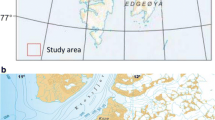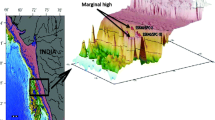Abstract
The concentrations of total mercury (Hg) and methyl mercury (MMHg) were determined in 78 marine sediments in the Iranian coastal waters of the Persian Gulf along nine transects perpendicular to the coastline. Total Hg ranged from 10 to 56 ng g − 1d.w. and MMHg from 0.1 to 0.4 ng g − 1 d.w. The fraction of methyl mercury accounted from 0.3% to 1.1% of the total mercury amount. The organic carbon (OC) content ranged from 0.4% to 1.8%. The present study indicates that the levels of Hg in the sediments of the Iranian coast of the Persian Gulf were all in the concentration range of unpolluted areas regarding Hg (<100 ng g − 1). The concentrations of total Hg, methyl mercury and organic carbon were generally higher in the deeper stations. Total Hg and MMHg were significantly correlated, but no significant correlations could be found between the Hg and OC levels.
Similar content being viewed by others
References
Aiken, G., Haitzer, M., Ryan, J. N., & Nagy, K. (2003). Interactions between dissolved organic matter and mercury in the Florida Everglandes. Journal de Physique. IV, 107, 29–32. doi:10.1051/jp4:20030235.
Al-Majed, N. B., & Preston, M. (2004). The distribution and inventory of total and methyl mercury in Kuwait Bay. Marine Pollution Bulletin, 49, 930–937. doi:10.1016/j.marpolbul.2004.06.018.
Benoit, J. M., Gilmour, C. C., Mason, R. P., & Heyes, A. (1999). Sulphide controls on mercury speciation and bioavailability to methylating bacteria in sediment porewaters. Environmental Science & Technology, 33, 951–957. doi:10.1021/es9808200.
Blanco, R. M., Villanueva, M. T. J. E., Urıa, J. E. S., Sanz-Medel, A. (2000). Field sampling, preconcentration and determination of mercury species in river waters. Analytica Chimica Acta, 419, 137–144. doi:10.1016/S0003-2670(00)01002-3.
Bloom, N. S., Colman, J. A., & Barber, L. (1997). A of methyl mercury during aqueous distillation and alternative techniques for the extraction of methyl mercury from environmental samples. Fresenius’ Journal of Analytical Chemistry, 358(3), 371–377. doi:10.1007/s002160050432.
Boening, D. W. (2000). Ecological effects, transport, and fate of mercury: A general review. Chemosphere, 40, 1335–1351. doi:10.1016/S0045-6535(99)00283-0.
CCME. Canadian Council of Ministers of the Environment (1999). http://www.ec.gc.ca/ceqg-rcqe/English/ccme/default.cfm.
Fitzgerald, W. F., Engstrom, D. R., Mason, R. P., & Nater, E. A. (1998). The case for atmospheric mercury contamination in remote areas. Environmental Science & Technology, 32, 1–7. doi:10.1021/es970284w.
Fitzgerald, W. F., & Mason, R. (1996). The global mercury cycle: Oceanic and anthropogenic aspects. In W. Baeyens, R. Ebinghous, O. Vasiliev (Eds.), Global and regional mercury cycles: Sources, fluxes and mass balances (pp. 85–108). Dordrecht: Kluwer.
Hammerschmidt, C. R., & Fitzgerald, W. F. (2004). Geochemical controls on the production and distribution of methyl mercury in near-shore marine sediments. Environmental Science & Technology, 38, 1487–1495. doi:10.1021/es034528q.
Hammerschmidt, C. R., & Fitzgerald, W. F. (2006). Methyl mercury cycling in sediments on the continental shelf of southern New England. Geochimica et Cosmochimica Acta, 70, 918–930. doi:10.1016/j.gca.2005.10.020.
Harada, M. (1995). Minamata disease: Methyl mercury poisoning in Japan caused by environmental pollution. Critical Reviews in Toxicology, 25(1), 1–24. doi:10.3109/10408449509089885.
Hellings, L. (2000). Origin and fate of dissolved inorganic and particulate organic carbon in a highly polluted estuary (The Scheldt) as traced by stable isotopes. PhD Thesis. Vrije Universiteit Brussel. 210 pp.
IAEA (1990). Survey of mercury in fish and sediment from the ROPME Sea Area. Monaco: IAEA International Laboratory of Marine Radioactivity, Final Data Report for the project Number KA/5102-82-10 (2363), Rev.7.
Kannan, K., & Falandysz, J. (1998). Speciation of mercury in certain coastal marine sediments. Water, Air, and Soil Pollution, 103, 139–136. doi:10.1023/A:1004967112178.
Kardovani, P. (1995). Iranian marine ecosystem; the Persian Gulf and the Caspian Sea, 2nd volume. Tehran: Ghomes.
Kelly, C. A., Rudd, J. W. M., & Holoka, M. H. (2003). Effect of pH on mercury uptake by an aquatic bacterium: Implication for Hg cycling. Environmental Science & Technology, 37(13), 2941–2946. doi:10.1021/es026366o.
Landaluze, J. S., de Diego, A., Raposo, J. R., & Madariaga, J. M. (2004). Methyl mercury determination in sediments and fish tissues from the Nerbioi-Ibaizabal estuary (Basque Country, Spain). Analytica Chimica Acta, 508, 107–117. doi:10.1016/j.aca.2003.11.070.
Leermakers, M., Baeyens, W., Quevauviller, P., & Horvat, M. (2005). Mercury in environmental samples: Speciation, artifacts and validation. Trends in Analytical Chemistry, 24, 383–393. doi:10.1016/j.trac.2004.01.001.
Leermakers, M., Gallettti, S., De Galan, S., Brion, N., & Baeyens, W. (2001). Mercury in the Southern North Sea and Scheldt estuary. Marine Chemistry, 75(3), 229–248. doi:10.1016/S0304-4203(01)00039-1.
Leermakers, M., Meuleman, C., & Baeyens, W. (1995). Mercury speciation in the Scheldt estuary. Water, Air, and Soil Pollution, 80, 641–652. doi:10.1007/BF01189717.
Leermakers, M., Meuleman, C., & Baeyens, W. (1996). Mercury distribution and fluxes in Lake Baikal. In W. Baeyens, et al. (Eds.), Global and regional mercury cycles: Sources, fluxes and mass balances (pp. 303–315). Norwell: Kluwer Academic.
Leermakers, M., Nguyen, H. L., Vanneste, B., Kurunczi, S., Galletti, S., & Baeyens, W. (2003). Determination of methyl mercury in environmental samples using static headspace gas chromatography and atomic fluorescence detection after aqueous phase ethylation. Analytical and Bioanalytical Chemistry, 377, 327–333. doi:10.1007/s00216-003-2116-6.
MacDonald, D. D., Ingersoll, C. G., & Berger, T. A. (2000). Development and evaluation of consensus-based sediment quality guidelines for freshwater ecosystems. Archives of Environmental Contamination and Toxicology, 39, 20–31. doi:10.1007/s002440010075.
Mikac, N., Foucher, D., Clarisse, O., Niessen, S., Lojen, S., Logar, M., et al. (2004). Relationship between mercury and solid sulfides in aquatic sediments. Proceedings in Materials and Geoenvironment, 51(Part 2), 1214–1214.
Morel, F. M. M., Kraepiel, A. M. L., & Amyot, M. (1998). The chemical cycle and bioaccumulation of mercury. Annual Review of Ecology and Systematics, 29, 543–566. doi:10.1146/annurev.ecolsys.29.1.543.
Muhaya, B., Leermakers, M., & Baeyens, W. (1997). Total mercury and methyl mercury in sediments and in the polychaete Nereis diversicolor at Groot Buitenschoor (Scheldt Estuary, Belgium). Water, Air, and Soil Pollution, 94, 109–123.
Muhaya, B., Leermakers, M., & Baeyens, W. (1998). Influence of sediment preservation on total mercury and methyl mercury analysis. Water, Air, and Soil Pollution, 107, 277–288. doi:10.1023/A:1019886606856.
Nguyen, H. L., Leermakers, M., Kurunczi, S., Bozo, L., & Baeyens, W. (2005). Mercury distribution and speciation in Lake Balaton, Hungary. The Science of the Total Environment, 340, 231–246. doi:j.scitotenv.2004.08.016.
Persaud, D., Jaagumagi, R., & Hayton, A. (1993). Guidelines for the protection and management of aquatic sediment quality in Ontario. Toronto: Water Resources Branch, Ontario Ministry of the Environment.
ROPME (1999). State of the marine environment report 1999. Kuwait: The Land Base of the Persian Gulf, ROPME, Marine Department of Environmental Organization of Iran.
ROPME (2004). The status of the marine environment report 2004. Kuwait: ROPME.
Tseng, C. M., De Diego, A., Martin, F. M., & Donard, O. F. X. (1997). Journal of Analytical Atomic Spectrometry, 12(6), 629–635. doi:10.1039/a700832e.
Ullrich, S. M., Tanton, T. W., & Abrdashitova, S. A. (2001). Mercury in aquatic environment: A review of factors affecting methylation. Critical Reviews in Environmental Science and Technology, 31, 241–293. doi:10.1080/20016491089226.
US EPA, US Environmental Protection Agency (2006). Great lakes contaminated sediments. http://www.epa.gov/glnpo/sediment/whitelake/4.0–4.1.htm.
WHO (1990). Environmental health criteria 101. Methyl mercury (p. 144). Geneva: World Health Organization.
Author information
Authors and Affiliations
Corresponding author
Rights and permissions
About this article
Cite this article
Agah, H., Elskens, M., Fatemi, S.M.R. et al. Mercury speciation in the Persian Gulf sediments. Environ Monit Assess 157, 363–373 (2009). https://doi.org/10.1007/s10661-008-0541-x
Received:
Accepted:
Published:
Issue Date:
DOI: https://doi.org/10.1007/s10661-008-0541-x




